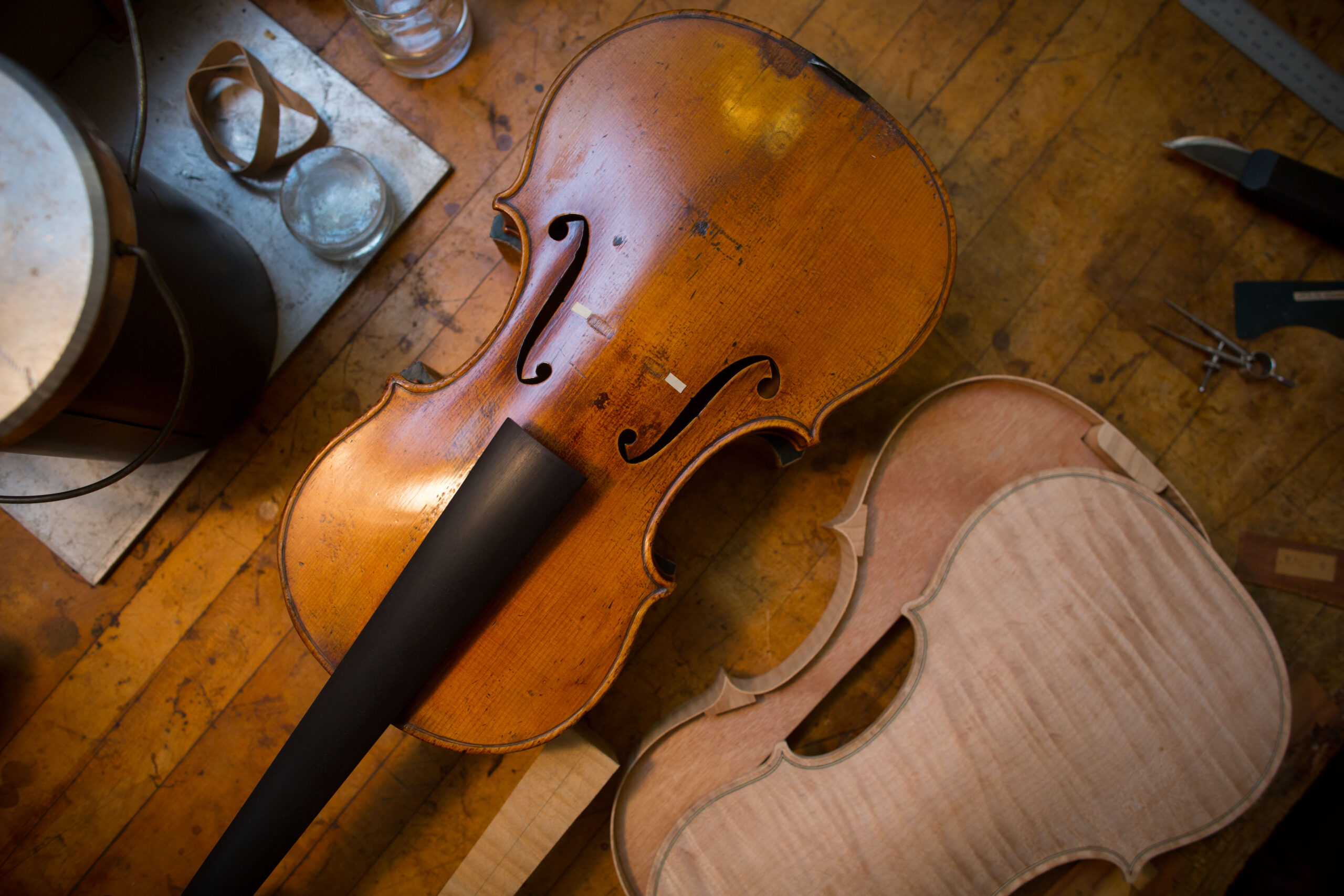One of Roman Totenberg’s first memories was of Moscow and his mother arriving home with a horse’s head to cook for dinner. Totenberg’s family had fled Poland at the beginning of World War I to avoid the fighting, but they could not avoid the famine that accompanied the Russian Revolution.
As luck would have it, one of their neighbors was a concertmaster at the Bolshoi Opera and offered to give young Totenberg violin lessons. Soon it became clear that Totenberg was no ordinary pupil; he was a child prodigy, and he traveled around the country performing at schools and Communist Party meetings where he was presented as Comrade Totenberg. He would come home from the concerts with some bread, butter, and sugar, providing for his family when his parents could not. Music saved his life, and Totenberg never seriously considered another career.
Over the next few decades Totenberg learned from and played with world-famous musicians in Paris, London, and Washington, D.C., eventually transforming into one of the cultural elite he once performed for. In 1938, on the eve of World War II, he immigrated to the United States after politically connected American friends in the arts community offered to sponsor him. Later in his life Totenberg offered the same assistance to other foreign musicians.
After decades of traveling the world, in 1961 Totenberg settled down as a professor at Boston University, where he encountered many aspiring young musicians, including a hotheaded violinist named Philip Johnson. The student was well known for his raw talent, his eccentricity (he wore gloves year-round to protect his hands), and his wild, untamed style. But Johnson seemed to spend more time bragging and arguing with professors than studying, and he failed multiple classes as a result. When school officials took up the question of expelling the young man for his poor marks, Totenberg was his only defender. Johnson was expelled anyway. Totenberg left the school later that same year to become director of the Longy School of Music in Cambridge, Massachusetts.
Two years later, in 1980, Totenberg was playing at a concert in his honor in Pickman Hall, a cozy, wood-paneled auditorium at Longy. As the performance drew to a close and the sounds of Mozart faded away, Totenberg placed his violin back into its case and carried it off the stage. He ducked into his office and set down the instrument before heading to a private reception with his friends and family. When he returned to pick up his violin later that evening, it was gone.
Totenberg was devastated; his stolen violin wasn’t just any old fiddle, but an instrument constructed in Cremona, Italy, by the famous luthier Antonio Stradivari. On the night of the theft Totenberg’s instrument was 246 years old and worth a small fortune.
Suspicions quickly centered on one audience member who seemed out of place that night: a now 27-year-old Philip Johnson, who for some reason had derided Totenberg ever since his days at Boston University. Why would Johnson show up to a concert featuring Totenberg, a musician he openly despised? He had been seen wandering around near Totenberg’s office earlier that day and was overheard complaining that Totenberg didn’t deserve his Stradivarius. Still, the evidence was circumstantial, and the police refused to issue a warrant to search Johnson’s apartment. According to Totenberg’s daughter Nina, her mother went so far as to ask friends if they knew anyone in the Mafia who could break in and look for it.
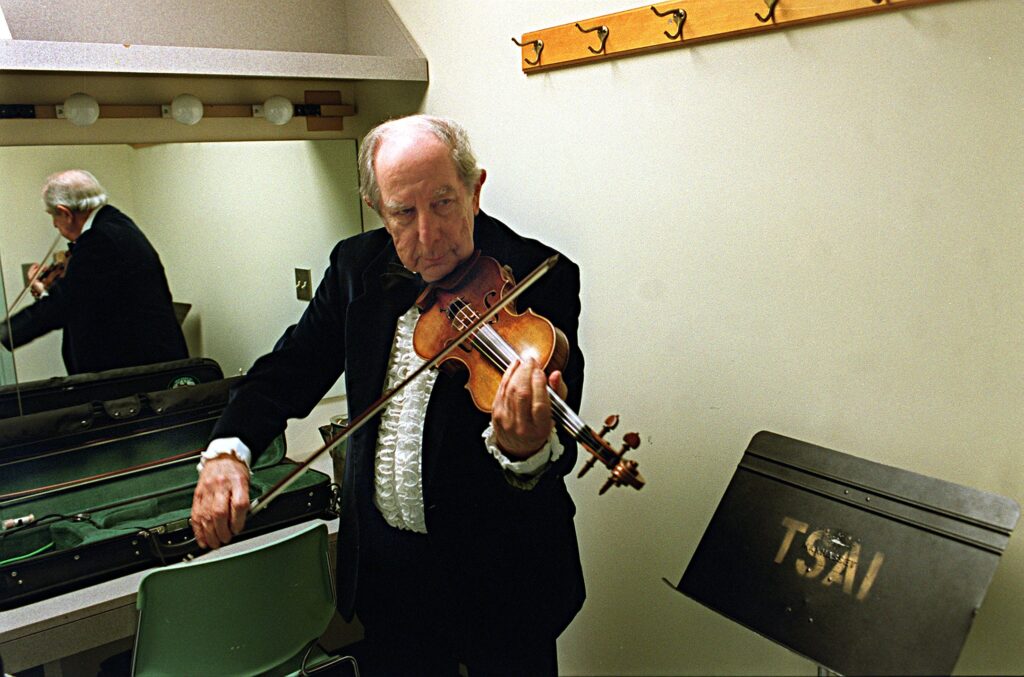
Violinist Roman Totenberg warming up before a 2001 concert at Boston University celebrating his 90th birthday.
What would drive one person to steal an instrument and another to go to such lengths to get it back? To many musicians and collectors a Stradivarius (or a Strad, as they are often called) is the gold standard of stringed instruments. Nothing made before or since, they believe, projects a superior sound; and of the 1,100 or so instruments Stradivari handcrafted in his lifetime, about 550 survive. Most of these remaining instruments have been painstakingly analyzed, authenticated, and catalogued. Today, each one is worth millions of dollars, and many have their own names. Totenberg’s violin, for example, was dubbed the Ames Stradivarius after the musician George Ames, who performed with it in the late 1800s.
The obsession with Stradivarius violins is not limited to musicians and thieves; for decades scientists have tried to figure out why a Strad sounds so much better than other instruments. Inquisitive luthiers, chemists, psychologists, historians, acoustic engineers, and even climatologists have scanned, deconstructed, and burned bits of Stradivarius violins in search of the Italian’s elusive secret. None have found a simple answer, but all begin with the assumption that Strads are superior to other instruments in terms of both sound and craftsmanship. What if they’re wrong?
Stradivari’s skill did not appear out of thin air; he learned from a long line of luthiers and apprentices based in the mercantile city of Cremona, who for hundreds of years produced the world’s finest instruments.
The city was first put on the map in the mid-1500s by the luthier Andrea Amati, who today is credited as the inventor of the modern violin. Amati’s craftsmanship was so valued that King Charles IX of France was given 38 of Amati’s instruments, a full orchestra of violins, violas, and cellos.
Before his death in 1577 Amati passed down his business to his sons, Girolamo and Antonio. One of Girolamo’s sons, Nicolò Amati, was the first Amati luthier to take on apprentices from outside the family. One of Nicolò’s apprentices was a young Italian named Andrea Guarneri, whose grandson Giuseppe eventually inherited the family business and became known as Guarneri “del Gesù” because, perhaps arrogantly, he signed each instrument with his own name followed by a sacred symbol for Jesus Christ. (When Totenberg lost his Strad, he replaced it with a 1736 Guarneri.)
Stradivari’s skill did not appear out of thin air; he learned from a long line of luthiers and apprentices based in the mercantile city of Cremona, who for hundreds of years produced the world’s finest instruments.
Stradivari, born in 1644, may have been another of Nicolò’s apprentices, although the only evidence of that is a label written on the oldest surviving Stradivarius. It reads, “Made by Antonio Stradivari of Cremona, pupil of Nicolò Amati, in 1666.” Whatever his training, Stradivari clearly idolized the Amati family’s work, right down to Andrea Amati’s penchant for innovation. Stradivari elongated the f-shaped holes cut into the top plate of his violins. He also flattened the arch (the elongated bump on the back of a violin), which supposedly allowed for better sound projection in the large concert halls being built at the turn of the 18th century. Finally, he embellished the ornate designs carved into the pegs and scrolls at the top of his instruments, treating them as works of art. At some point during Stradivari’s life, musicians and audiences came to believe that his creations had some intangible quality that made them sound better than other violins. It wasn’t long before his fame surpassed that of the Amati family, and wealthy nobles were lining up to purchase his instruments.
Like the elder Amati, Stradivari passed down his business to two of his sons, but the instruments they built never captured the magic of their father’s creations. After Guarneri and the last of the Amati luthiers died, the quality of Cremona’s instruments declined quickly, although the town’s reputation as a place of fine craftsmanship persisted. Cremona has remained a hub for schools that teach the craft of violin making, but the unique quality of instruments from Stradivari’s generation is lost. Since then luthiers around the world have been trying to get that something special back, and they’re not alone.
In 2003 a team of scientists thought they found at least part of Stradivari’s lost secret.
Dendrochronologists, scientists who study the rings of trees, started with the long-standing assumption that denser rings result in more resonant wood. They proposed that the spruce trees used by Stradivari and other Cremonese luthiers had grown during an unusually cold period between 1645 and 1715. The low temperature caused the trees to grow very slowly, creating dense clusters of rings and a tighter grain, which they suggested led to a better sound. After publication the theory was embraced by a number of luthiers. Other researchers, including the acoustics physicist Colin Gough, pointed out there is no evidence that better resonance is caused by denser wood. A Science article summed up Gough’s thoughts: “It’s exceedingly difficult to find measurable differences in the tonal quality of the cherished old violins and more ordinary ones, let alone explain what causes them.”
If cold weather contributed to the brilliance of Stradivari’s violins, no one has yet confirmed how or why. But dendrochronologists have built on that study and carved out a role authenticating and dating old instruments by comparing the physical patterns of tree rings on violins with historical and environmental records. For example, if the grain of the spruce in a violin is particularly narrow, they might be able to estimate it was grown in a certain part of the Alps during the 1645-to-1715 cold period and help a collector figure out if their violin came from Stradivari’s hands.
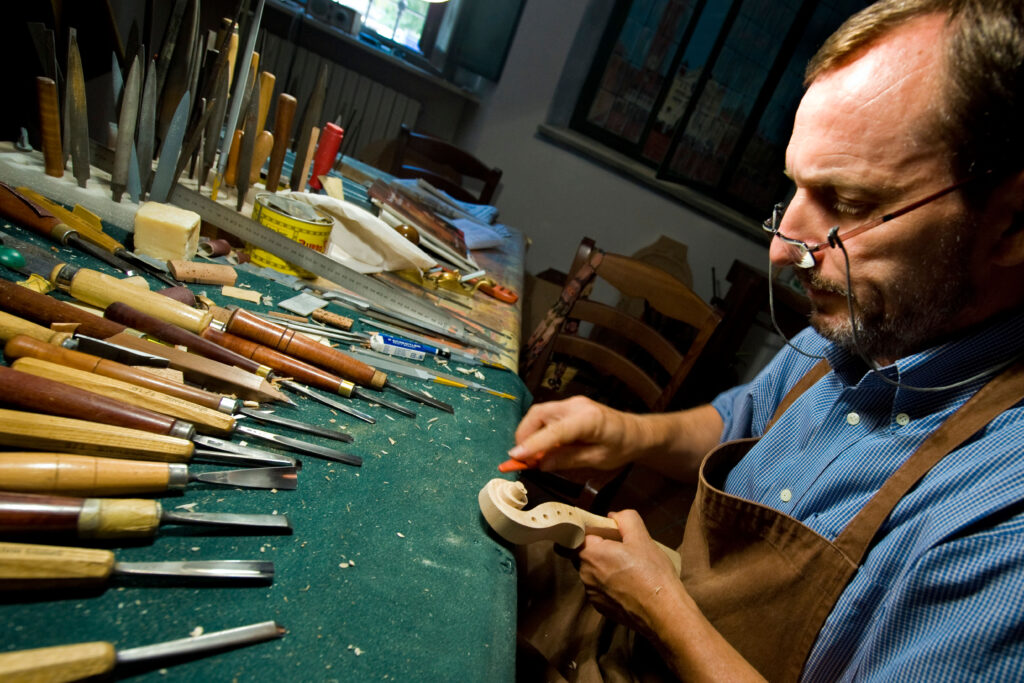
Though the work done in Cremona today is not considered on par with Stradivari’s and Guarneri’s creations, the city remains a hub for instrument making. Here a luthier with Francesco Bissolotti and Sons refines a violin scroll, 2009.
Another popular theory is that Stradivari had a secret recipe for his varnish that was responsible for the unique sound of his instruments. Various studies have purported to find remnants of eggs, honey, and even fossilized amber embedded in his varnish. In 2009 those theories were mostly disproved by a comprehensive chemical and spectrographic analysis conducted by a team of French chemists. The researchers, led by museum curator and chemist Jean‐Philippe Echard, failed to detect any evidence of these ingredients in five different instruments made during the span of three decades. Instead, they found that Stradivari’s recipe called for many of the same oils and tree resins used by modern luthiers.
Another study, conducted by a chemistry lab at National Taiwan University, went even further. Researchers solicited tiny slivers of wood shaved from a handful of Strads, which they unceremoniously burned. An analysis of the released gases found trace amounts of aluminum, copper, and calcium, possibly the remnants of chemical preservatives applied to the wood long before Stradivari got his hands on it. That is, we may have loggers to thank for this exceptional sound.
To make sense of these conflicting theories I sought out someone who is intimately familiar with the connection between the materials an instrument is made of and the sound it projects. After calling around to local businesses in Philadelphia, I located Christopher Germain, a luthier who makes violins that match the style, dimensions, and even the species of tree once used by Stradivari, Guarneri, and other Italian violin makers from the 18th century. I told Germain about my story, and he invited me to come visit him at his store.
Germain’s violin shop is located inside a red brick apartment building in Rittenhouse Square, one of Philadelphia’s toniest neighborhoods. I almost walked right past because the only sign of its existence was a small plaque on the wall. Germain buzzed me up and ushered me into a room with an oriental rug covering a hardwood floor and decorated with dark leather couches and display cases filled with violins. Standing in the luxurious room made me feel like I was inside one of Stradivari’s grand violins. Although I don’t know how to play a stringed instrument, I was tempted to put down a deposit.
When I took a closer look at the violins in the cases, I noticed they were scuffed and faded, as if their varnish had been rubbed away over the years by the hands of many musicians. I was more than a little surprised when Germain quietly informed me that these instruments were mostly brand new. Germain said concert violinists prefer violins that look old even if they aren’t; otherwise their instruments would reflect too much light and distract the audience. But perhaps the bigger reason is that in the music world, old is in. Antique Cremonese instruments are held in such high regard that even people who don’t own one want to blend in with the Stradivari aesthetic.
So what did Germain make of theories that try to explain why Strads have the best sound?
“They say, ‘Well, what is Stradivari’s secret?’ It’s like saying, ‘What is Michelangelo’s secret?’ ” he told me. “Or to assume, ‘Well, if I just had the same kind of paint that he had, I could do what he did.’ The truth is that Stradivari was such a great craftsman, he did everything right.”
In other words there is no one thing that makes older Cremonese instruments superior to modern violins. Stradivari trained for decades with the Amati family, carefully measuring and fitting together the pieces of each instrument and using only the highest-quality materials. He also competed with other violin makers in Cremona, including Guarneri, which raised the quality of everyone’s work.
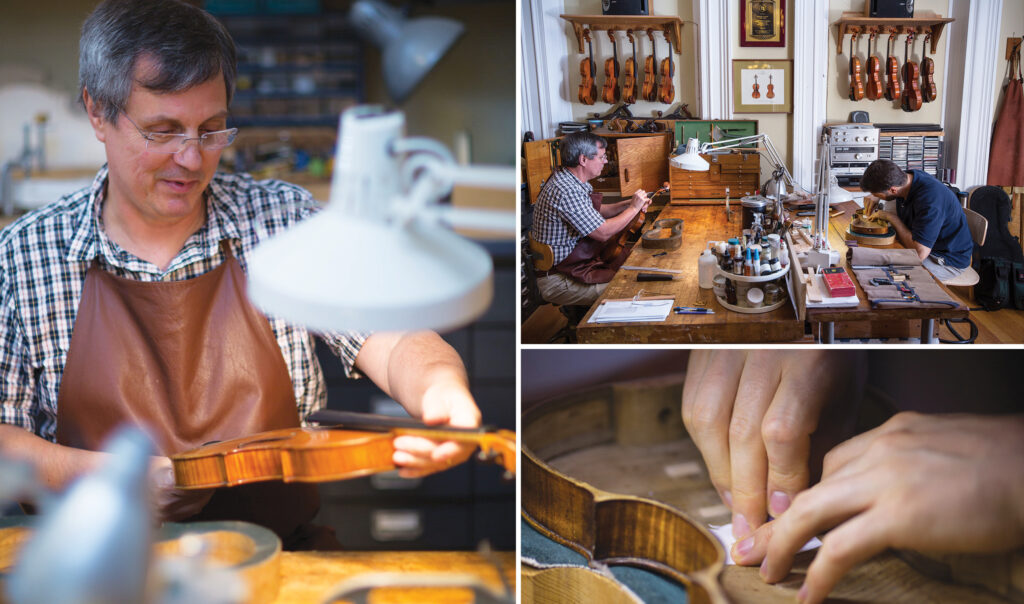
Philadelphia-based luthier Christopher Germain makes violins that mimic the tone and aesthetics of the classic Cremonese creations. “For me, the challenge is to make a contemporary instrument which has the same qualities and enables the player to do the same things that the great instrument of the past does,” he says.
But even Germain was not completely immune to the allure of speculating about Stradivari’s secret.
“If you said, ‘Tell me one thing that makes Stradivari instruments so much better than others,’ I probably would say the varnish. The varnish is very important in the sound because remember, this is like a coating over the entire instrument, and it’s going to affect how the wood vibrates and resonates, and it’s also meant to protect the wood.”
The only problem with that theory, as Germain pointed out, is that surviving Cremonese instruments appear to have hardly any varnish left on them.
To show me what he was talking about, he brought me to the workshop at the back of his store. Hanging on the wall was an Amati violin he was restoring for a client. When he flipped it over, only a few faded splotches of varnish remained. The rest had rubbed off over years of playing. “What’s in the wood and what’s on the wood are two different things,” he said mysteriously. Later, I worked out he was probably referring to the 2009 French study led by Echard; the researchers found that even where varnish appears to be missing on Cremonese instruments, much of it has been absorbed by the top few layers of plant cells. There it continues to protect the wood and—possibly—influence the sound.
Germain makes his own varnish, although he does not use any secret ingredients (not that he would reveal them to me if he did)—just the usual combination of resin, oil, and pigment. Surprisingly, Echard’s study also suggested that Stradivari didn’t make his own varnish, which means he was using the same stuff everyone else in Cremona had access to.
“You would go to the apothecary in town, and he would provide you with whatever materials were there,” explained Germain. “It wasn’t just Stradivari. It was that Cremonese varnish at the time, which also lends some credibility that there was something … special, but it was not special to one maker only. Guarneri’s varnishes are fantastic, too, and other makers as well.”
But even if Germain had the recipe for that special Cremonese varnish, he doesn’t think he would be able to replicate its unique properties.
“How you cook it, the type of materials you use, the temperature, the length of time, will create a varnish with certain characteristics,” he said. Since Germain cannot replicate the hands-on knowledge passed down by varnish makers to their apprentices in 1700s Cremona, undoubtedly he would get different results. Germain himself makes only small batches of varnish at a time because his recipes occasionally produce unexpected outcomes he might have to throw away.
I was intrigued that even someone as experienced and technically minded as Germain would put stock in the varnish theory. Maybe the scientists were wrong. Perhaps only a virtuoso, someone capable of teasing out every last tone and nuance from a Strad, would truly understand what makes it sound so good.
It so happens I know two very accomplished musicians, Laura Hamilton and Lanny Paykin, who also happen to be my girlfriend’s parents. Hamilton plays violin and is principal associate concertmaster of the Metropolitan Opera Orchestra; Paykin is a freelance cellist who regularly plays at Lincoln Center, for Broadway shows, and in film and TV appearances. We got together in my cramped West Philadelphia apartment to talk about what makes the sound of Cremonese instruments unique.
Neither owns a Stradivarius or Guarneri nor has an obsession with the instruments, but like most classical string players they believe there is something special about the sound of those instruments, whether that sound is produced by the precise assembly, the wood, or the varnish. Hamilton, who has played at least a few notes on a friend’s Strad, tried to describe the sound of the best instruments to me:
“I think it’s a combination of focus and projection, which we need for our big concert halls, and also just warmth and richness, interesting timbre, interesting texture, not just a laser-beam sound, you know?”
Hamilton noticed my bewildered look and quickly explained that there is an entire lexicon of musical terms most people are unfamiliar with, not unlike how wine connoisseurs speak of “zippy” and “mossy” tastes. Still, it was the first time I had heard the term laser beam applied to classical music.
That exchange left me wondering if any researchers had asked professional musicians to nail down their musical preferences in a scientific way. Germain, during our interview, had mentioned a researcher named Claudia Fritz at Pierre and Marie Curie University in Paris who works in a field with such an intriguing name I had to double-check to make sure I heard it correctly.
The field is called psychoacoustics, and it sits at the intersection of psychology and acoustics engineering. Instead of measuring sound waves, Fritz and her colleagues study how people subjectively perceive sound. Ask Fritz the old question about a tree falling in the woods with no one to hear it, and her professional assessment would probably be “who cares?”
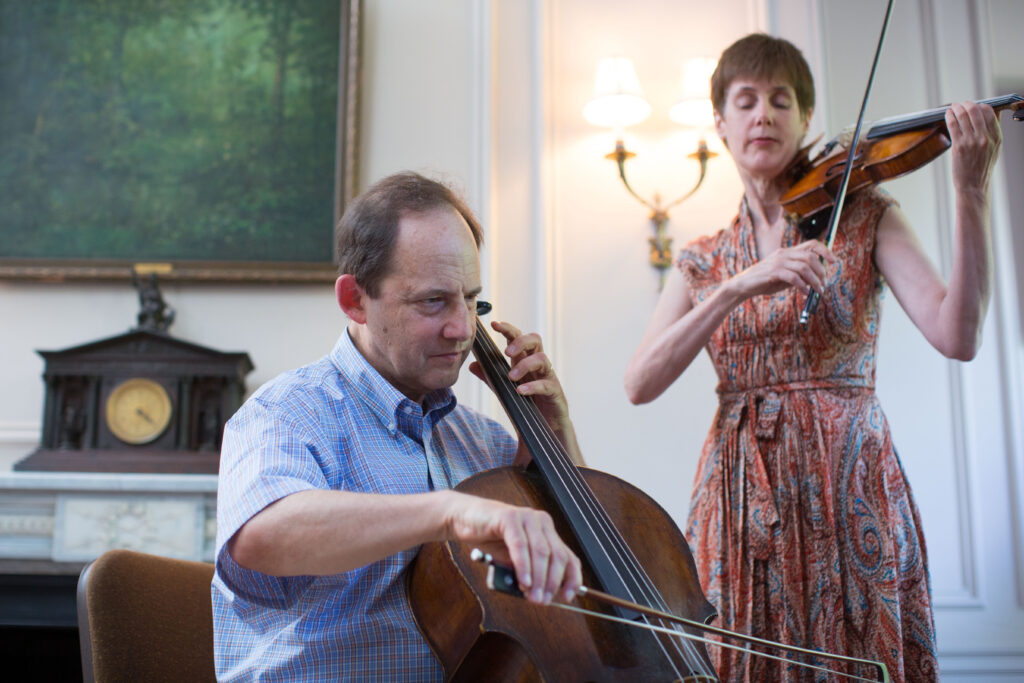
Musicians Lanny Paykin (left) and Laura Hamilton at Philadelphia’s Curtis Institute of Music, July 2017. While Paykin asserts there is something unique about the sound of a classic Italian instrument, the tool is only responsible for so much. “There was that funny story: somebody was complimenting Jascha Heifetz and said, ‘Oh, Mr. Heifetz, the sound of your violin is so wonderful!’ So Heifetz took the violin and held it [to his ear]. . . . ‘I don’t hear anything.’”
When I looked into Fritz’s research, I found that in 2010 she had conducted a double-blind experiment to determine whether skilled violinists could tell the difference between older and newer instruments. During a violin competition in Indianapolis, Fritz invited 21 musicians to a hotel room and presented them with six violins; two were Stradivari, one was a Guarneri, and three were modern violins disguised to look and feel like antiques. She turned the lights down low and gave the test subjects welder’s goggles so they couldn’t see which instrument they were playing. She also sprayed perfume on the chinrests so they couldn’t differentiate the instruments by smell. Then each participant had one minute to test the violins in pairs, with one modern and one old in each pairing. In each of 10 pairings players were told to pick the instrument they preferred. When that was finished, the test subjects were given 20 minutes to play any of the violins and rate them in terms of tone, response, playability, and projection. Finally, they were asked to choose which violin they would take home if they could.
Fritz found that 13 of the 21 subjects picked a modern violin to bring home, and one of the Strads was universally disliked in almost every category. When the musicians were asked to guess if the instrument they chose was old or new, only three answered correctly.
The results of the experiment were widely reported in the media: “Out of tune: Concert violinists can’t identify the sound of a multi-million-pound Stradivarius,” read a headline in the Daily Mail, a British tabloid. The New Scientist reported that “pro violinists fail to spot Stradivarius in blind test.” Many other outlets accepted the test as evidence there was nothing special about Stradivarius violins when stripped of their context. I, too, was ready to write off the mystique of Cremonese instruments until I stumbled across a 2012 blog post written by Laurie Niles, one of the musicians who participated in the test.
Niles was unhappy with the way the media portrayed the results and identified a few methodological errors she thought might have affected the experiment. First, she pointed out, the study was not testing a musician’s ability to distinguish a Stradivarius from a modern instrument. It was specifically asking participants to choose the one they preferred to play, which could be influenced by something as trivial as size (people with small hands prefer small violins) or the fact they were in a hotel room with poor acoustics.
Second, Niles had reason to believe the Cremonese instruments might have been compromised before the test began. While the modern violins were chosen for their quality and carefully tuned and adjusted before the experiment, the three older instruments were loaned to Fritz under the condition they not be adjusted at all. If a sound post fell out of alignment during the trip to the hotel, no one was allowed to fix it, and the violin would sound worse than a modern one through no fault of its own. Niles theorized that the universally disliked Strad may have been the victim of such an event.
In the end Niles concluded that the experiment was more of a compliment to modern violins than it was an indictment of older ones. Fritz later responded to Niles’s critique in a comment on the webpage where it was posted, thanking her for providing a counterpoint to the media’s reporting of the study; Fritz eventually set up a website of her own to better explain her methodology. Perhaps the differing interpretations of the test and all its variables were just as subjective as the quality of the sound Fritz was testing. Maybe psychoacoustics isn’t the best way to figure out what makes a Strad special.
If the quality of a great instrument can’t be identified by the ear of a subjective listener, then maybe it can be identified by a machine. In 2016 Marjan Sedighi-Gilani, an engineering researcher in Zurich, used just such a machine to test whether varnish had a noticeable effect on a violin’s sound. She and her colleagues acquired wood samples from trees typically used for violin making. They then coated each piece of wood with one of four different varnishes, two of them created in her lab and two of them acquired from German violin makers who brew varnish in the traditional Cremonese way. Sedighi-Gilani then sent pulses of sound through the wood while scanning the samples with X-ray tomography, the same type of technology used to identify brain injuries. In this case the scans provided hundreds of different cross-sectional slices of the insides of each sample. After putting the slices together, the researchers created a three-dimensional map of the wood as it vibrated in response to the sound waves.
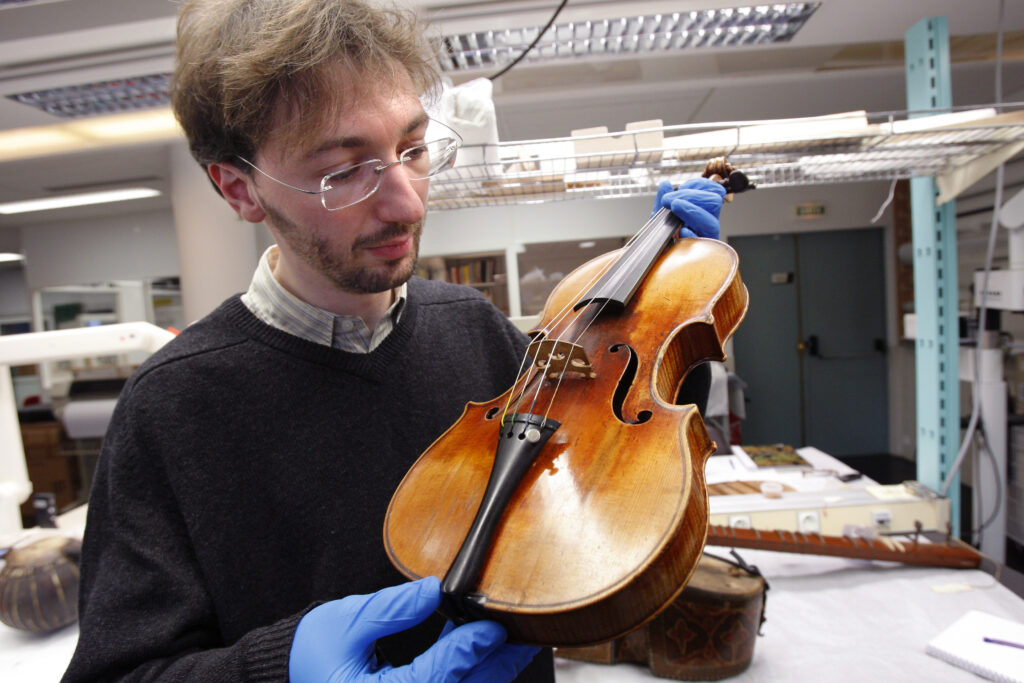
French chemist Jean-Philippe Echard holds a Stradivarius violin at the Musée de la Musique in Paris, 2009. The superior acoustics of Stradivari’s violins have often been attributed to the varnish the master used, but a spectrographic analysis conducted by Echard found nothing unusual in the coating.
Sedighi-Gilani found that the presence of varnish dampened sound while pushing it out perpendicular to the grain of the wood. (Normally, instruments with no varnish project sound in the same direction as the grain.) In other words the varnish quickly silenced the violin after it started vibrating, while simultaneously projecting sound more evenly in all directions. The professional varnish made by the German violin makers caused more damping and projection than the lab-made varnish. Paykin likened the effect to “an actor who will do a stage whisper.”
“You can hear it in the back of the hall. He’s whispering, but you hear every quality of the sound. The same thing happens when you hear a great instrument. It can be played softly, but will be heard clearly.”
The researchers also discovered that the lab-made varnish penetrated deep into the wood and thinned out over time. Scans of instruments from Stradivari’s era revealed varnish that remained thick and stayed closer to the surface, even though much of it was not visible to the naked eye, as I witnessed in Germain’s shop. That thickness and stability may have preserved the instruments’ damping and projecting abilities over hundreds of years.
Of course, machines can’t tell you if a Strad sounds better than a modern violin. Sedighi-Gilani could only conclude that varnish has a physical effect on the sound of an instrument. This may seem obvious; the materials that are part of an instrument influence its sound. But every time researchers make another connection (in this case between varnish and projection), luthiers like Germain are one step closer to having full control over the sound of the instruments they make.
At this point in my research I had talked to professional musicians, interviewed a violin maker, and read countless scientific studies, but I hadn’t looked into the perspective of an average audience member. Cremonese instruments only became famous because people listening to them decided they sounded better than other instruments. Do they still hold up when the audience doesn’t know they are hearing a Strad?
While the professional musicians in Fritz’s double-blind test were confined to a small hotel room, recent audience listening tests suggest that people can tell the difference between a Strad and a modern violin in a large concert hall where projection trumps everything. In April 2015 an informal experiment was set up at the Barbican Centre in London. Before the London Symphony Orchestra performed that evening, the concertmaster of the orchestra, Roman Simovic, played six violins for the audience, one of which was a Stradivarius. After Simovic finished playing, the audience overwhelmingly voted for the Strad as their favorite. (Notably, Simovic had little to no experience playing any of the instruments that night except for the Strad, which he owned and had been performing on for years.)
“If you are told in advance that you’re listening to a Stradivarius, there’s that halo. I think it’s called a halo effect in science. You expect things to be better or different than what they are.”
A much sneakier experiment was conducted in 2007 by Washington Post columnist Gene Weingarten during rush hour in the Washington, D.C., subway. Weingarten teamed up with the renowned violinist Joshua Bell and his 300-year-old Strad, known as the Gibson ex-Huberman, which, like Totenberg’s Strad, had once been stolen and was lost for decades. Bell, who normally performs in a slick black dress shirt in sold-out concert halls, was practically unrecognizable in jeans and a baseball cap as he began busking next to a trash can just outside the L’Enfant Plaza Metro Station. Meanwhile Weingarten, using a hidden camera, watched commuters pass by. Over the course of 45 minutes more than 1,000 people walked by one of the most talented musicians in the world playing on one of the most highly regarded instruments ever made. Only seven stopped to listen, and only one recognized who Bell really was. (Bell cleared $32 for his trouble.)
Weingarten’s experiment wasn’t exactly a fair assessment of an audience’s ability to recognize a Stradivarius; after all, most of the unwitting participants were just trying to get to work on time. But the stunt does support the idea that out of context a Cremonese violin sounds about the same as any other professional-quality instrument. Even the people who stopped to listen to Bell might have been just as likely to stop for any busker. In that sense the secret of a Strad could be dismissed as mere cognitive bias; people expect it to sound better than it really does, and they let themselves believe it is special because they want it to be. It would be pretty disappointing to pay hundreds of dollars for a concert ticket, or millions of dollars for a violin, and not get what you were hoping for. Germain touched on this idea during our interview: “If you are told in advance that you’re listening to a Stradivarius, there’s that halo. I think it’s called a halo effect in science. You expect things to be better or different than what they are.”
Fritz came to a similar conclusion in a second double-blind test conducted in 2012 that addressed all the methodological concerns of the first one. The new experiment took place in a huge concert hall as well as a rehearsal room in Paris. Fritz invited 10 of the most renowned soloists in the world, and participants were given more time with twice as many instruments. They were also allowed to play their own instruments as a point of comparison. The results were almost identical to the first test; the most preferred violin was modern, and the most disliked violin was a Stradivarius. The musicians were able to guess which instruments were old or new at a rate of about 50%, no better than a coin flip.
The final nail in the violin case, at least for me, was when I discovered that Fritz published yet another study in May 2017, after I started researching this article. This latest study appeared to debunk the idea that Cremonese instruments can be played softly while projecting sound extremely far. In two double-blind tests an audience of 55 people in Paris and 82 in New York claimed that modern violins were consistently louder than Stradivaris or Guarneris, both on the stage and at the back of the auditorium. And Fritz once again found that the modern violins were rated higher for general sound quality by both the performers and the audience.
Few people took issue with the experiments. Some of the subjects suggested the test couldn’t account for the possibility that modern violins are much easier to master right away, but Cremonese instruments require patience and practice that only pays off months or years down the road. Niles (who did not participate in the later studies) chimed in to warn that an experiment that tested just a handful of violins should not be generalized to all Cremonese instruments. Others conceded that after participating in the experiment, they saw no reason for a rising-star musician to buy an antique Italian instrument when they could have something just as good for a fraction of the price. Comments like that may drive fear into the hearts of violin dealers, who thrive on selling multimillion-dollar instruments to musicians and collectors alike. But any such fears are premature: the market for fine Italian instruments continues to thrive. In 2011 the Lady Blunt Stradivarius, one of the best-preserved Strads in the world, sold at auction for $15.9 million and still holds the record for the most expensive Cremonese instrument. On the lower end, Strads in worse condition sell for $1 million to $3 million, but collectors predict their value will double every 10 years.
Philip Johnson almost certainly would have disagreed with Fritz’s findings. Just as everyone suspected, he was the one who took Totenberg’s Stradivarius. After the heist he made off to New York before joining a South American orchestra; he eventually settled in California. Unlike many art and instrument thieves, Johnson never had any intention of selling his loot.
Johnson failed to make a living as a musician and was so broke he had to shoplift food from grocery stores to eat, but still he didn’t sell his filched prize. Instead, he went to great lengths to hide his secret while brazenly playing the violin in an improvisational band and in church performances. Whenever fellow musicians asked to see his fiddle with the incredible sound, he made an excuse and tucked it back in its case. Unable to bring it to a professional repair shop for fear of getting caught, he held it together with Elmer’s glue and tried to keep the instrument tuned and in working order himself.
None of Johnson’s friends in California suspected his old violin was a Strad, not even his wife, Thanh Tran, whom he met at a concert in the early 1990s. Tran became infatuated with Johnson’s musical abilities and happily supported him for years while he tried to get a stable job. Eventually, Johnson’s passion for music was replaced by a costly addiction to stock trading bankrolled by his frustrated wife, who soon divorced him.
By early 2011 Johnson was falling into worse shape than the Stradivarius, and a doctor told him why: pancreatic cancer. After trying and failing to come up with the money to record a final concert with his prized violin, Johnson died at age 58 without ever confessing to his crime. Johnson left the violin, which he claimed was worth about $30,000, to Tran.
In 2015 Tran sent photographs of the instrument to an appraiser, who immediately recognized it as an authentic Stradivarius. After comparing it to a compendium of all known Stradivarius instruments, he asked to meet with her to examine the instrument in more detail. Speaking with National Public Radio, the appraiser later remembered telling Tran, “The good news is that this is a Stradivarius. The bad news is it was stolen 35, 36 years ago from Roman Totenberg.” The appraiser called the FBI to report the discovery, and two hours later agents showed up to reclaim it for its rightful heirs, Totenberg’s three daughters. (Totenberg had died in 2012 at age 101.) Nina, the oldest daughter, was the reporter who wrote about the retrieval for NPR; the missing violin, she said, haunted her father’s dreams for the rest of his life.
Despite years of neglect the old violin was in surprisingly good condition. Whether or not Johnson knew it, the cheap Elmer’s glue he used to patch the Strad was water soluble, meaning it expanded and contracted with the wood of the instrument instead of resisting the natural changes in humidity and cracking it further. There’s no denying that Stradivari’s craftsmanship lends his instruments incredible longevity, even when they are not perfectly maintained. After only a year of restoration work Totenberg’s violin had a new sound post and new strings, and was finally ready to return to the stage. (The only thing missing was the original bow, which was never found.) Totenberg’s daughters asked close family friend and virtuoso Mira Wang to play it in public for the first time since it was recovered. Wang had been one of Totenberg’s star pupils after he sponsored her to study at Boston University in 1986 when she was still a student in China. She was one of the many musically talented immigrants Totenberg helped bring to the United States throughout his life.
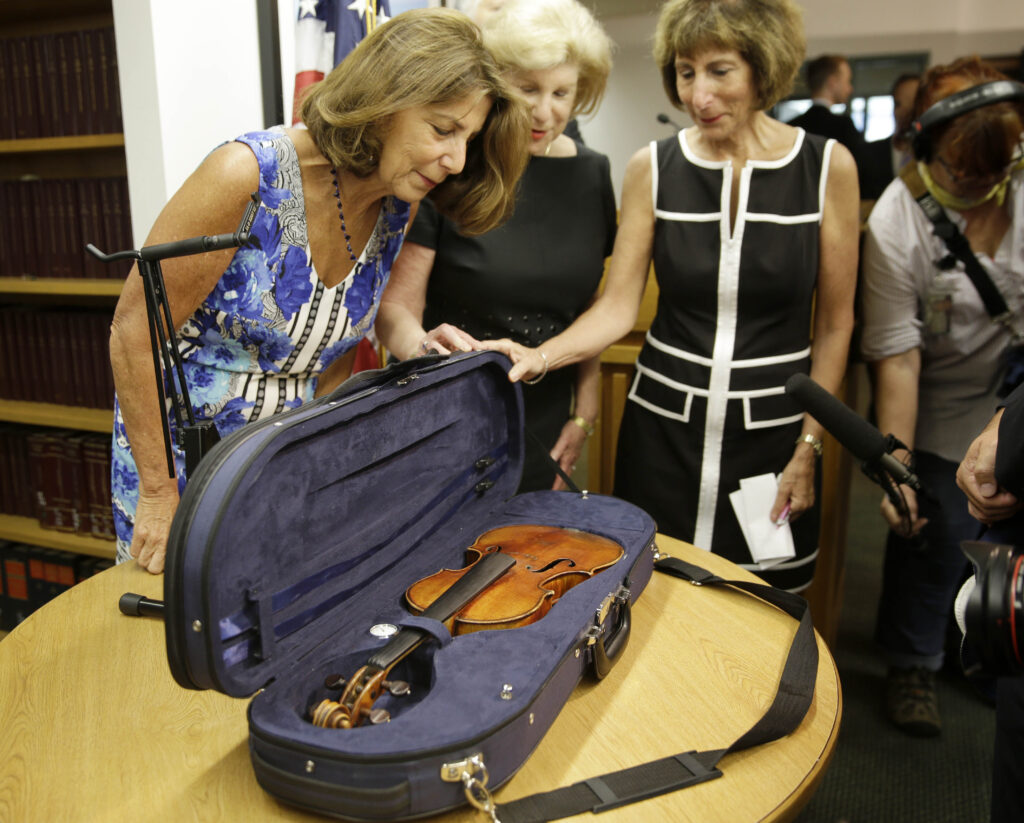
The Totenberg sisters, Amy, Nina, and Jill, at the press conference announcing the recovery of their father’s long-lost Stradivarius, 2015.
Speaking to the Associated Press in the days leading up to the concert, another of Totenberg’s daughters, Jill, noted how much the instrument meant to their family. “I’m sure we’ll all cry. I’m absolutely sure of it,” she said. “When that violin was returned to us, we really felt like our father was back in the room with us that day.”
On March 14, 2017, Wang performed with Totenberg’s Strad in front of 200 people at an undisclosed club in New York City, starting with the music of Belgian composer Eugène Ysaÿe. In attendance were the violin’s restorer, the FBI agent who recovered it, a handful of reporters, and, of course, the three Totenberg sisters. By all accounts the concert was a triumph. After the concert the Totenbergs announced they were planning to sell the violin to a musician rather than a collector so it would be heard again.
Wang’s performance was always in danger of being overshadowed by expectations of the violin itself; not only did the instrument have to live up to Stradivari’s reputation, but it also had to bring closure to a family drama lasting nearly 40 years. But when Wang played the first note of Ysaÿe’s Violin Sonata No. 2 that night, no one was scanning sound waves, analyzing a swab of varnish, or comparing the sound to that of a modern violin. They were just enjoying a masterful performance delivered on an instrument burnished with history and meaning.
Even if the secret of a Stradivarius is that there is no secret, does it really matter? It’s impossible to calculate the precise quality of a great painting, and so too it seems for Cremonese violins; so much of the value is subjective, determined by the player and the listener. No matter how many studies Fritz and other researchers do to prove that a Strad is unexceptional, people will attribute to it something more, whether it be status, sound quality, or something as inconsequential as smell and texture. When a performer truly connects with an instrument, it ceases to be just the materials that make up its physical properties; it becomes an extension of the performer’s body, an appendage imbued with the power and weight of 300 years of history. Perhaps that intersection of material and feeling is the extra layer of brilliance that audiences claim to hear when they insist that a Stradivarius is extraordinary.

